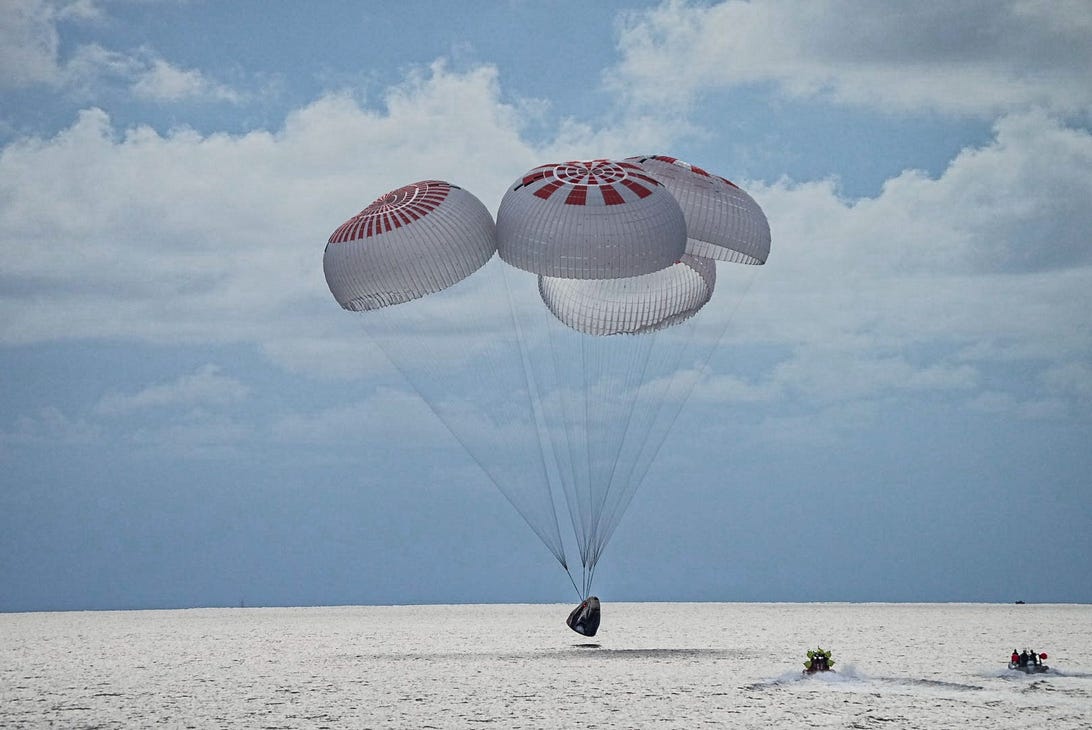SpaceX Inspiration4 mission splashes down in first Atlantic Ocean landing

Homeward bound.
Inspiration4
Best three-day “weekend” ever? That may be the question SpaceX’s four civilian astronauts are putting to themselves after successfully returning to Earth on Saturday. The crew of the historic Inspiration4 mission splashed down off the Florida coast at about 7 p.m. local time, after having orbited the globe many times since Thursday. The astronauts safely exited the spacecraft about an hour after splashdown, following a recovery at sea.
“That was a heck of a ride for us,” mission commander Jared Isaacman tweeted after splashdown. “Congratulations @Inspiration4x!!!” SpaceX CEO Elon Musk said, also via Twitter.
It was the first time a crew composed of private citizens had been launched into orbit, without any professional astronauts aboard. The mission took the crew members much farther out than either Virgin Galactic’s Richard Branson or Blue Origin’s (and Amazon’s) Jeff Bezos traveled on their recent jaunts above the planet. And the Inspiration4 trip helps solidify the notion of sending everyday people into space, for tourism, futuristic international travel and perhaps even colonization of the cosmos.
The mission was bankrolled by Isaacman, a former pilot and the billionaire founder of a payment processing company, who offered up the other three seats to members of the general public: physician assistant Hayley Arceneaux, data engineer Christopher Sembroski and community college professor Sian Proctor (who’s now also the first Black woman to pilot a spacecraft).
Read more: Why the SpaceX Inspiration4 mission matters to everyone
The crew spent its time orbiting the Earth every 90 minutes (about 100 miles farther out than the International Space Station); checking out the view of our planet from a specially installed glass cupola on SpaceX’s Dragon capsule; conducting various science experiments; and occasionally taking breaks to play with a plushie pup (also known as the mission’s “zero gravity indicator”). Physiological information about the crew was collected to assess changes in behavior and cognition, including data on heart rate, blood oxygen saturation and how well the team members slept.
The mission was also billed as a fundraiser for St. Jude’s Children’s Research Hospital, where Arceneaux works and where she was a cancer patient as a child.
The successful mission is another feather in the cap of Musk and his company SpaceX, which has already shuttled astronauts to the International Space Station as part of NASA’s Commercial Crew Program. That initiative sees the space agency working with private companies to achieve NASA’s stated goal of “safe, reliable and cost-effective access to and from the International Space Station and low-Earth orbit.”
In June, SpaceX signed a deal to send space tourists to the ISS, starting next year. And in April, NASA announced that it had selected SpaceX to provide the human landing system for the space agency’s Artemis program. Artemis calls for putting the first woman and next man on the moon sometime soon — and eventually setting up sustainable exploration there. Knowledge gained from Artemis will be put to use in getting ready to send astronauts to Mars.
Read more: Welcome to Mars (special report)
For all the latest world News Click Here

